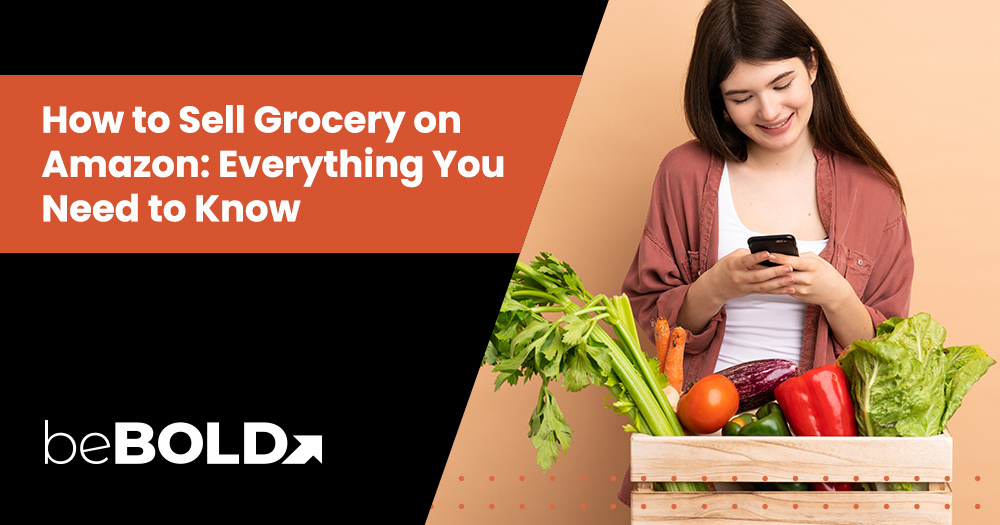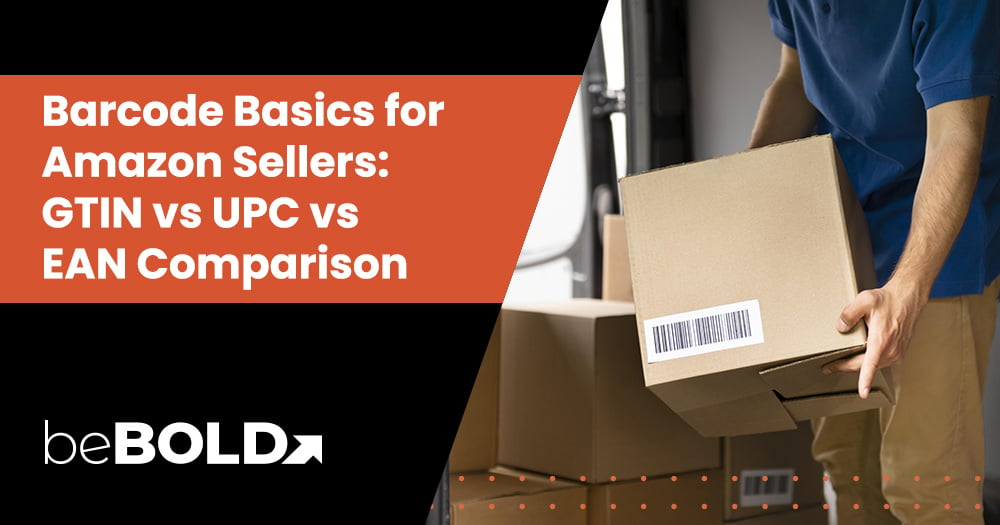The grocery industry has transformed in the past few years, with more consumers turning to online platforms for their shopping needs. According to Statista, approximately 150 million Americans, or nearly half of the nation’s population, buy groceries online. Between 2018 and 2023, the US market for online grocery sales increased by 19.5% annually. Because of the convenience and accessibility, these numbers will only go up.
Amazon, the eCommerce giant synonymous with streamlined shopping experiences, is among the frontrunners in this revolution. This platform presents a golden opportunity for entrepreneurs to tap into a vast market and reach more audiences. As consumer behaviors evolve, so must your strategies. Staying ahead of market trends and knowing the ropes is paramount to success.
Whether you're a seasoned seller looking to expand your offerings or a budding entrepreneur venturing into online grocery sales, this article shares how to sell groceries on Amazon and thrive in this dynamic space.
How to Sell Grocery on Amazon? Step-by-Step Guide

So you've decided to sell groceries on Amazon, an excellent choice. But first, you need to equip yourself with the right knowledge through thorough market research. Here is the first step in a step-by-step guide on selling groceries on Amazon.
Step 1: Create a Professional Seller Account

Before you can list any products on Amazon, you'll need a seller account. So, the first step is to create a seller account. There are two maim types of seller accounts you’ll come across, individual and professional. Here’s the difference between the two.
Difference Between Individual and Professional Accounts:
Individual:
- Lower monthly fees ($0.99 per item sold)
- Suitable for occasional sellers with low sales volume
- Limited selling features and reporting
Professional:
- Higher monthly fee ($39.99 per month)
- Recommended for serious sellers with higher sales volume
- Access to advanced selling tools, bulk uploads, and reporting features
For selling groceries, a professional seller Account is strongly recommended due to the higher volume of sales and the need for advanced inventory management tools.
Step 2: Request Approval for Grocery Category

To sell groceries on Amazon, you must request category approval by submitting necessary documents like a business license, supplier invoices, and proof of product authenticity. Ensure your products comply with Amazon’s packaging, labeling, and expiration date requirements. Apply through Seller Central and wait for Amazon’s review. Once approved, you can start listing and optimizing your grocery items for sale.
Why is Grocery a Restricted Category?
The grocery category on Amazon has strict regulations to ensure food safety and quality for consumers. This includes requirements related to product sourcing, handling, storage, and labeling.
How to Check for Pre-Approval:
- Log in to your seller central account.
- Navigate to the "Inventory" tab.
- Click on "Add a product."
- Search for your product.
- If the product is restricted, you will see a message indicating that approval is required.
How to Apply for Approval and What’s Required:
Go to the "Selling on Amazon" page and find the "Apply for Selling Privileges" section.
- Select the "Grocery" category.
- Complete the application form, providing all the required information, such as your business information, product details, and food safety certifications.
- Submit your application for review.
Step 3: Meet Amazon’s Food Safety and Quality Standards

To sell food products on Amazon, sellers must adhere to strict safety and quality standards to ensure customer trust and compliance with regulations. These standards include proper labeling with ingredients, allergens, and expiration dates, as well as safe packaging to prevent contamination. Products must also meet legal requirements, such as FDA regulations for the U.S. or equivalent authorities in other regions.
Seller Requirements:
- Obtain necessary licenses and permits: This may include a food handler's permit, a business license, and a sales tax permit.
- Maintain a clean and sanitary facility: Ensure your storage and handling areas meet all food safety regulations.
- Implement proper inventory management: Track expiration dates and rotate stock to prevent spoilage.
Product Requirements:
- Source products from reputable suppliers: Ensure the quality and safety of your products.
- Meet all relevant food safety standards: This may include FDA regulations and other applicable standards.
- Properly label all products: Include accurate product information, ingredients, and expiration dates.
Listing Requirements:
- Accurate and detailed product descriptions: Include information about ingredients, nutritional facts, and any relevant certifications.
- High-quality images: Use clear and attractive images that accurately represent the product.
- Competitive pricing: Research competitor pricing and adjust your prices accordingly.
Requirements for Food Safety Certifications:
- Obtain relevant certifications: This may include certifications such as HACCP (Hazard Analysis and Critical Control Points) or SQF (Safe Quality Food).
- Maintain compliance with certification standards: Regularly undergo audits to ensure compliance with certification requirements.
Packaging and Labeling Guidelines:
- Use appropriate packaging materials: Choose packaging that protects the product from damage and contamination during shipping.
- Clear and accurate labeling: Include all required information, such as product name, ingredients, net weight, nutritional information, and expiration date.
- Comply with all labeling regulations: This may include FDA regulations and other applicable labeling requirements.
Expiration Dates for Amazon Groceries:
- Monitor expiration dates closely: Ensure all products are sold before their expiration date.
- Implement a system for tracking and rotating inventory: This will help you minimize spoilage and avoid losses.
- Consider offering discounts on items nearing their expiration date: This can help you clear out stock and avoid waste.
Step 4: Choose the Right Fulfillment Method
Selecting the right fulfillment method is crucial for ensuring smooth operations and customer satisfaction when selling on Amazon. Sellers can choose between:
- Fulfillment by Amazon (FBA): Amazon handles all aspects of fulfillment, including storage, picking, packing, shipping, and customer service.
- Pros: Increased visibility in search results, faster shipping times, eligibility for Prime benefits.
- Cons: Higher fulfillment fees, potential for longer storage times, less control over customer service.
- Fulfillment by Merchant (FBM): You are responsible for all aspects of fulfillment, including storage, picking, packing, shipping, and customer service.
- Pros: Lower fulfillment fees, more control over customer service and shipping.
- Cons: Requires more resources and infrastructure, may not be eligible for Prime benefits.
For perishable groceries and other meltable products, FBA may be a good option due to its efficient meltable inventory requirements fulfillment capabilities and faster shipping times. However, FBM can also be a viable option, especially if you have a well-established fulfillment process and can offer competitive shipping rates.
Great Business Methods for the Grocery Category:
- Retail Arbitrage: Purchase items at a discount from retail stores and resell them at a profit on Amazon.
- Wholesale: Purchase products in bulk from distributors and resell them on Amazon.
- Private Label: Create your own brand of grocery products and sell them exclusively on Amazon.
Step 5: Optimize Product Listings
Optimizing product listings is essential for increasing visibility and driving sales on Amazon. Focus on creating keyword-rich titles, clear and engaging descriptions, and bullet points that highlight key features and benefits. Use high-quality images that showcase your product from multiple angles and ensure the information aligns with customer search intent. Well-optimized listings improve rankings and help convert more shoppers into buyers.
Best Practices for Listing Groceries:
- Use high-quality images: Use clear, well-lit images that accurately represent the product.
- Write compelling product titles: Include relevant keywords to help customers find your products.
- Create detailed product descriptions: Highlight the key features and benefits of your product.
- Use a+ content (if applicable): Enhance your product listings with rich media elements, such as images, videos, and infographics.
Best Practices for Writing Product Descriptions:
- Use clear and concise language: Avoid jargon and technical terms.
- Highlight the key features and benefits of the product: What makes your product unique and desirable?
- Include relevant keywords: This will help your products rank higher in search results.
- Use bullet points to make your descriptions easy to read: This will help customers quickly scan the information.
- Include information about ingredients, nutritional facts, and any relevant certifications.
By following these steps and adhering to Amazon's strict documentation regulations, you can successfully sell groceries on Amazon while meeting seller performance targets and building a profitable business. Remember to prioritize customer satisfaction, provide excellent customer service, and continuously adapt your strategies to stay competitive in the marketplace.
8 Tips for Selling Groceries on Amazon Successfully

Selling groceries on Amazon can be a lucrative business venture, but it requires careful planning and execution. Here are eight essential tips to help you succeed:
1. Monitor Customer Feedback
Customer feedback is invaluable for any business, but it's especially crucial in the competitive world of online grocery sales. Regularly monitor customer reviews and ratings to identify areas for improvement. Pay close attention to feedback about product quality, packaging, shipping times, and overall customer satisfaction. Address negative feedback promptly and professionally, and use positive feedback to inform your marketing efforts.
2. Establish a robust supply chain
A reliable supply chain is essential for successfully meeting consumer demand and maintaining product quality. Identify and choose trustworthy suppliers who can consistently provide fresh and premium groceries. To maximize savings and guarantee a steady supply of products, bargain for favorable terms with your suppliers.
3. Craft captivating product listings
If you want to drive sales, you have to attract customers first. Ensure your product titles accurately portray your item and write compelling descriptions highlighting key selling points. Doing keyword research and applying them will also increase your products’ visibility and push for more sales.
These practices will differentiate and elevate your products from competitors. It also helps to utilize high-quality images to showcase the appeal of your groceries and enhance customer engagement.

Source: Amazon
4. Master pricing strategies
Another way to boost sales is by having affordable products. Analyze market trends to understand competitor pricing and identify opportunities to offer promotional pricing strategies. Discounts and deals are excellent at attracting new customers while encouraging repeat purchases.
Employ dynamic pricing techniques to adjust your prices in real time and maximize profits. For example, sellers may raise prices during periods of high demand or low inventory to capitalize on higher demand and increase earnings. Conversely, during slower periods or to attract more customers, prices can be lowered to remain competitive and stimulate sales.
5. Explore fulfillment options
Choosing the right fulfillment option is crucial for efficiently delivering your groceries to customers. Consider utilizing Fulfillment by Amazon (FBA). Selling groceries on Amazon with FBA streamlines order fulfillment and gives access to Prime shipping benefits.
If you're looking into self-fulfillment, carefully evaluate the pros and cons, taking into account cost savings and your shipping capabilities. The main idea for this strategy is to select the fulfillment option that ensures timely delivery and customer satisfaction.
6. Harness the power of marketing
Leveraging Amazon's advertising tools is essential for increasing visibility and driving sales. You can promote your groceries to a wider audience more effectively by utilizing Sponsored Products, Sponsored Brands, and Sponsored Display ads.
Furthermore, you can craft targeted advertising campaigns based on customer demographics and interests to maximize conversions. As you optimize your product listings with relevant keywords and Amazon ad management, you improve search visibility and attract more customers.
7. Consider Expiring Products
When selling groceries, it's crucial to be mindful of product expiration dates, especially the earliest expiration date of your items. Implement a system for tracking inventory using an inventory file template and prioritizing the sale of items nearing their expiration date. You can offer discounts on these items to clear out your stock and avoid spoilage.
8. Track Inventory Carefully
Maintaining accurate inventory levels is essential for smooth operations and customer satisfaction. Regularly track your inventory to avoid stockouts and overstocking. Utilize inventory management software to streamline this process and ensure you always have the right amount of product in stock.
Pricing Your Grocery Items
Setting the right price for your grocery items on Amazon is crucial for maximizing sales while maintaining profitability. Since grocery products have tight margins and frequent fluctuations in costs, sellers must adopt a strategic pricing approach.
- Analyze Competitor Pricing – Monitor similar products to stay competitive. Use Amazon’s pricing tools or third-party software to track changes and adjust accordingly.
- Factor in Amazon Fees – Consider referral fees, FBA (Fulfillment by Amazon) costs, and storage fees when setting your price to ensure profitability.
- Account for Supply Chain Costs – Include sourcing, packaging, and shipping expenses in your pricing strategy to maintain healthy margins.
- Utilize Dynamic Pricing – Leverage automated repricing tools to adjust your prices based on demand, competition, and market trends.
- Offer Promotions & Bundles – Discounts, coupons, and bundle deals can increase your sales volume while keeping your price competitive.
- Monitor Profit Margins Regularly – Grocery prices can fluctuate due to seasonality and supplier costs, so consistent evaluation is key to sustaining profitability.
By implementing a well-researched pricing strategy, you can stay competitive, attract customers, and grow your grocery business on Amazon.
How Important it is to Find a Wholesale Distributor?
Finding the right wholesale distributor can be a game-changer for businesses, especially those looking to expand their reach and increase sales. Here's why:
- Market Access: Wholesale distributors have established networks of retailers, enabling businesses to tap into new markets and reach a wider customer base. This can be particularly beneficial for smaller businesses that may lack the resources to reach out to individual retailers.
- Cost Savings: Distributors often purchase goods in bulk, allowing them to negotiate better prices from manufacturers. These savings can be passed on to businesses, making their products more competitive in the market.
- Reduced Operational Costs: Distributors handle various aspects of the supply chain, including warehousing, inventory management, and transportation. This frees up businesses to focus on other core areas, such as marketing and product development.
Finding a wholesale distributor requires research and networking to ensure you source quality products at the best prices. Start by searching online directories like Wholesale Central, ThomasNet, or SaleHoo, which list verified distributors across various industries. Attending trade shows and industry events is another effective way to connect with suppliers and negotiate deals.
You can also contact manufacturers directly and ask for a list of their authorized distributors. Additionally, networking in online forums and business groups can help you find recommendations from experienced sellers. When evaluating a distributor, consider factors such as pricing, minimum order quantities, shipping policies, and customer reviews. Requesting product samples and verifying the distributor’s credentials before committing to a partnership can help ensure reliability and quality.
What is the Difference Between a Co-op Wholesale Listing and an Amazon Matching Listing
This refers to a product listing created by a group or co-op of wholesalers who collaborate to supply products in bulk. In this model, the co-op acts as the primary seller, managing inventory, pricing, and fulfillment. This approach allows for better pricing control and shared operational responsibilities among wholesalers.
Meanwhile, an Amazon matching listing occurs when multiple sellers offer the same product already listed on Amazon. Instead of creating a new listing, sellers "match" their inventory to the existing listing using the product’s ASIN (Amazon Standard Identification Number). All matched sellers compete for the Buy Box, which is influenced by factors like price, shipping speed, and seller performance.
Here is a detailed comparison between the two in a table format.
|
Aspect |
Co-op Wholesale Listing |
Amazon Matching Listing |
|
Definition |
A listing where multiple sellers can sell the same product at wholesale prices under a shared brand. |
A listing created by Amazon that allows multiple sellers to list the same product, but based on Amazon's product data. |
|
Seller Requirements |
Sellers need to be part of the co-op program, often with specific agreements. |
Sellers need to meet Amazon’s standards for product listings, with approval from Amazon to match an existing listing. |
|
Product Control |
Sellers have more control over pricing and product availability, within co-op rules. |
Sellers follow Amazon’s pricing and listing rules, with less flexibility. |
|
Branding |
Typically operates under a shared co-op brand. |
Operates under the original product brand as listed by Amazon. |
|
Price Flexibility |
Sellers often have more freedom to set prices within agreed wholesale rates. |
Prices are influenced by Amazon’s algorithms and other sellers, but there is some price flexibility. |
|
Visibility |
Product visibility can depend on co-op agreements and the overall group’s marketing efforts. |
Visibility depends on Amazon’s algorithm, which includes seller performance, reviews, and price competitiveness. |
|
Sales Channel |
Focused on wholesale distribution, often aimed at bulk buyers. |
Primarily retail-focused, aimed at individual consumers. |
Dominate the Amazon Grocery Market with BeBOLD Digital
Amazon provides an incredible opportunity for entrepreneurs to showcase their grocery products, reach a larger audience, and drive sales. You can position your business for long-term success in this competitive space by implementing proven strategies and optimizing your approach.
However, excelling in Amazon’s grocery category requires more than just a strong start—it demands ongoing learning, strategic adjustments, and expert guidance. That’s where BeBOLD Digital comes in.
We offer comprehensive services, including full Amazon account management, advertising campaigns, SEO optimization, and brand store creation. Our expertise in analytics, inventory management, and daily account monitoring ensures your grocery business stays competitive and profitable.
Take the next step toward success in the Amazon grocery marketplace—contact BeBOLD Digital today and let’s grow your business together.
Frequently Asked Questions
1. How can I ensure the quality and safety of my grocery products?
It's vital to establish robust quality control measures throughout your supply chain. These include sourcing from reputable suppliers who adhere to stringent quality standards, regularly inspecting incoming shipments for freshness, and complying with regulations.
To maintain product quality, implement proper storage and handling practices, such as temperature control and hygiene protocols. Moreover, regular product testing and quality assurance checks verify that your groceries meet safety and quality specifications.
2. What are the specific requirements for labeling groceries on Amazon?
You must provide accurate and detailed product information such as product name, brand, quantity, expiration date, and nutritional information. Ensure that labels are clear, legible, and prominently displayed on the packaging to give customers essential information about the product they purchase. Labels must also comply with applicable regulatory requirements like FDA guidelines for food labeling.
3. What are the pros and cons of using Fulfillment by Amazon (FBA) for groceries?
The pros of using FBA for groceries include access to Prime shipping benefits, streamlined order fulfillment, and customer trust in Amazon’s reliable delivery network. However, the cons are limited control over inventory management and the risk of mishandling perishable items during storage or shipping. There may also be storage and fulfillment fees.
4. How can I stay up-to-date on changes in Amazon's grocery selling policies?
Regularly monitor Amazon's Seller Central portal for updates. You can also subscribe to relevant newsletters or email notifications from Amazon and join seller forums or communities. Likewise, following Amazon's official social media channels and blogs can get you updates regarding grocery selling policies.
5. Is selling groceries on Amazon profitable?
Selling groceries on Amazon can be profitable, but success depends on product selection, pricing strategy, fulfillment costs, competition, and other factors. The right approach allows sellers to capitalize on demand and generate revenue. That's why practicing strategic sourcing, efficient fulfillment methods, and effective marketing is crucial.
Take your Amazon grocery business to the next level—partner with BeBOLD Digital today and let’s grow your success together.








Comments